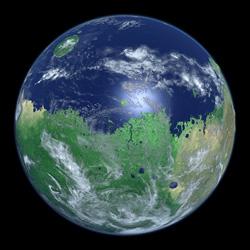The Mars Curiosity rover has found that the environment on Mars, at least locally, was once warm and wet, with a chemistry that would support life in the form of Earth-like micro-organisms.
That’s amazing. We were expecting this, or at least hoping it would be true, but to see it actually happen, well. That’s amazing.
In a nutshell, Curiosity drilled into a rock to examine it chemically, and found evidence of clay minerals, which form in water. We’ve seen this before on Mars, but another important aspect of this is that it looks like the water that formed these minerals was neutral, not too strongly acidic or basic. Other places on Mars have chemistry that would be hostile to life as we know it, containing molecules like perchlorates that are very reactive with organic molecules; that it; destroying them. Curiosity also found the presence of sulfur, phosphorus, and carbon, all necessary ingredients to make life as we know it.
To be clear, Curiosity did not find evidence of life! It has been looking for organic compounds but has not yet found them. But it did find conditions were once conducive for it. For all the details of what Curiosity found and how it found them, go read Emily Lakdawalla’s post about this on The Planetary Society Blog.
Given all this, it seems clear that the region where Curiosity landed was once very wet, and for a long time. It was probably a lake bed, fed by a river or stream that spread out into what’s called an alluvial fan. These are similar to river deltas—both are where the water spreads out and deposits material—but alluvial fans are more typical of flooding events. Either way, fresh (or only slightly salty) water once stood where Curiosity sits now.

Image credit: Kevin Gill
It’s hard not to let imagination soar a bit with this news. We’ve been imagining a wet Mars for a long time—even using geological data to model what it would look like with oceans—and science fiction is rife with Martians. Much of the thrust of NASA’s overarching goal for Mars missions has been looking for life, or at least the conditions for it. They’re not coy about that, either.
And what we have now isn’t science fiction any more. Not really, at least, not really fiction. It’s speculation based on solid scientific evidence, extrapolation, but nothing is being made up. Over time, we’ve built up quite a case that Mars may have once been suitable for life; the first probes to go there found it to be dead and dry, but subsequent missions have shown that’s too sweeping a statement. Ice has been found just under the surface at mid-latitudes, insulated by the rock and dust above it. Evidence that standing water existed is everywhere, from dry lake beds like Curiosity’s landing site to strong hints of ancient oceans.
And all this leads to the very simple question: Did Mars once or does it now have any kind of life?
I’m not looking for slimy Martians that regard this Earth with envious eyes. I’ll be very, very happy with positive evidence of microbes. This is no easy task, since our probes and rovers aren’t really designed to look for those. And a big problem is that not finding them is not evidence they are not there. As we have seen, conditions varied wildly across the Red Planet, with some places being rather clement with other locations being outright hostile to life. We may just be looking in the wrong place. You have to be careful and not use that as an argument to keep looking forever, of course, but with what we know now, it seems like looking harder is the next step.
And these new findings by Curiosity make it seem likely that, at the very least, we’re moving in the right direction. It’s possible life doesn’t need warm weather, water, and the same chemicals we have here on Earth to form. But we do know that’s how it worked here, so it’s the best line of evidence to follow.
We’ve now taken another step along that path. We don’t know where it leads, but then, that’s why we explore, isn’t it? We don’t know what we’ll find, except that, as is usual in science, we’ll find things that surprise us. And if you ask almost any scientist, you’ll find that’s their motivation to explore. The surprises are the best part.
And the idea of finding life on another planet? As it turns out, the potential for huge discoveries in science is somewhat motivating, too.
